The time for the MLS Cup final has come after a long season which spread throughout the year. There were teams who saw their play-off dream fell through, while stronger teams were hoped to advance further but didn’t make it ‘till the end. Eventually, we are left with two teams waiting to be crowned as champion.
Seattle Sounders came into the play-off stage being the second-seeded team in the Western Conference. They had a pretty decent regular season but found themselves in between a huge gap from the top team, LAFC. Brian Schmetzer’s side started the play-off quite struggling as they needed extra time to grind the win over FC Dallas. Still, two outstanding performances against Real Salt Lake and especially LAFC secured them the Western Conference trophy and the chance to host the MLS Cup final.
Meanwhile, Toronto FC ended the regular season in fourth and was drawn against DC United for their first playoff match. A comfortable win saw them being matched up with two top-seeded teams later on in New York City FC and Atlanta United respectively. It proved to be quite tough for Greg Vanney’s side but they eventually ended up on the winning end thanks to two goals when the game started to approach the end.
This tactical analysis preview will provide an analysis on the MLS Cup final between Seattle Sounders and Toronto FC. Meanwhile, using statistics and footages, we will take a brief look at Schmetzer’s tactics and Vanney’s tactics and how they could exploit each other’s weaknesses.
Predicted lineups
Seattle are expected to lineup in a similar way as they did in their previous three matches. In their 4-2-3-1 formation, Stefan Frei will obviously be the first choice in goal for the side. The biggest question that Schmetzer is facing right now is to choose between Román Torres, who has been starting in the first two play-off matches, or Xavier Arreaga, who provided a good performance against LAFC. There is a possibility that the American coach will pick experience over youth with the Panamanian centre-back lining up alongside South Korean defender Kim Kee-hee.
There will be no major change to the lineup given the fact that most players are eager to step out onto the field and make sure the trophy remains at the CenturyLink Field. But against Toronto, wingers Jordan Morris and Joevin Jones might swap place with each other. These two have thrived in the role of inside forwards over the course of the season, still, their pace and dribbling ability can prove to be crucial in stretching Toronto’s defensive juggernaut.
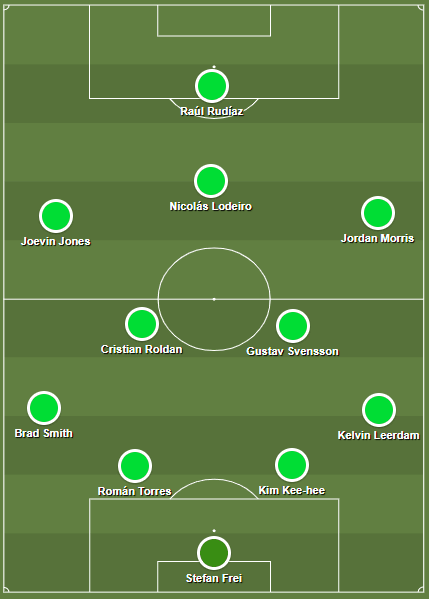
Vanney is known for springing tactical surprises in the previous play-off editions. In contrast to what he lined his side up in the regular season, the Virginia-born manager tends to choose a different formation for Toronto. This match won’t be an exception, either, as he is aware of Seattle’s attacking force.
Playing with a 5-3-1-1 block is one of the options that is being considered in recent weeks. A 4-3-3 formation has proved its efficiency in the last three matches, but solid at the back is what can be crucial in this game for Toronto. Laurent Ciman has seen his form improved during the play-off stage while Omar Gonzalez immediately became a key player for the Canadian side after he joined from Pachuca. Linking these two players up with Chris Mavinga playing slightly to the left can help Toronto achieve what they want.
Having more defenders also means that the front line will have to be cut short. Nicolas Benezet and Tsubasa Endoh might appear on the bench as Irish striker Patrick Mullins is expected to lead the line along with Alejandro Pozuelo. Veteran Jozy Altidore remains a doubt but Vanney hopes him to involve in the match in his recent interview for the MLS official website.
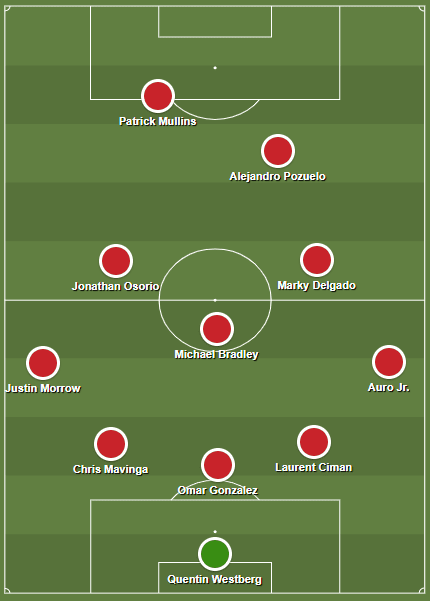
Seattle’s attack against Toronto’s defence
In possession, Seattle tend to move the ball in a quick fashion. They aim to progress the ball high up the pitch as quick as possible using short combinations between the players. Directly from the build-up process, Frei could look to distribute the ball out wide which allows full-backs Brad Smith and Kelvin Leerdam to make overlapping runs immediately. Not only it reduces the time that the ball stays with the defence, but it also gives them the opportunity to exploit gaps being created inside the opposition’s half.
Against Toronto’s press, this strategy can become an efficient solution for the home side to bypass the pressure from the opposition. Given that Toronto will play with the 5-3-1-1 formation, there will only be two players pressing Seattle’s defence while the others stand in between the option of staying in their positions or push up to join the press. Specifically the full-backs, who will face the pressure of leaving Jones and Morris unmarked if they decide to close down Seattle’s full-backs.
In their 4-3-3 formation, things seem to be much easier for the visitor. Both wingers will close the centre-backs down and the striker would apply pressure on the goalkeeper, forcing him to clear the ball, similar to the shot below. At the same time, two central midfielders can even push up to mark the opposition’s pivots, which in this situation were Atlanta’s Jeff Larentowicz and Darlington Nagbe.
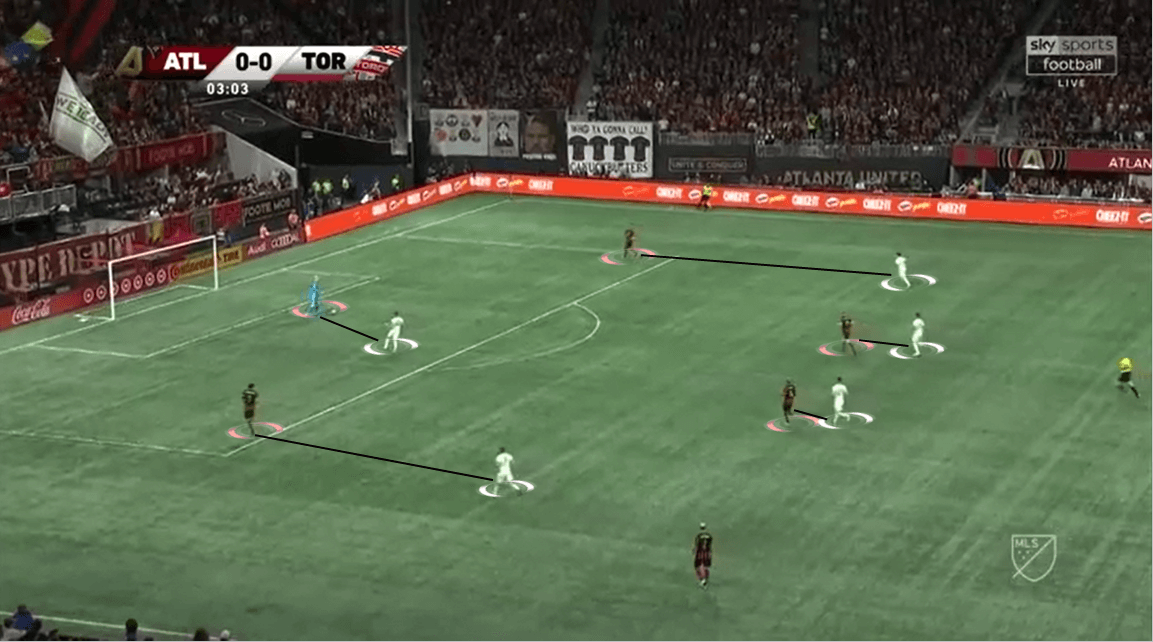
One thing that needs to be focused on, though, is Seattle isn’t good in controlling possession. Although their possession stat below indicates they usually have more of the ball than their opponents (52.19% compared to 47.81%), it is easy for the home side to lose possession under aggressive pressure.
Due to the fact that they move the ball quickly, misplaced passes and heavy touches are sometimes unavoidable. This will allow their opponent to recover possession without involving in defensive duels and could even lead to a dangerous counter-attack.

Toronto’s high press can capitalise on this to win the ball back inside the opposite half and catch Seattle on a quick break. By pushing their shape higher up the pitch, it is viable for the Canadian side to have more players for the counter, which can hurt Seattle if they commit too many players for a potential attack.
When Seattle do manage to get the ball forward, they usually put an emphasis on attacking down the left-hand side. It is a very familiar scene for their fans to see Smith using his pace to overlap down that side and picking up the ball from Nicolas Lodeiro. Meanwhile, Morris would drift inside and spend most of his time inside the left half-space. Also, the American forward sometimes switches position with Raúl Rudíaz and allows the Peruvian striker to drop deep for the ball.
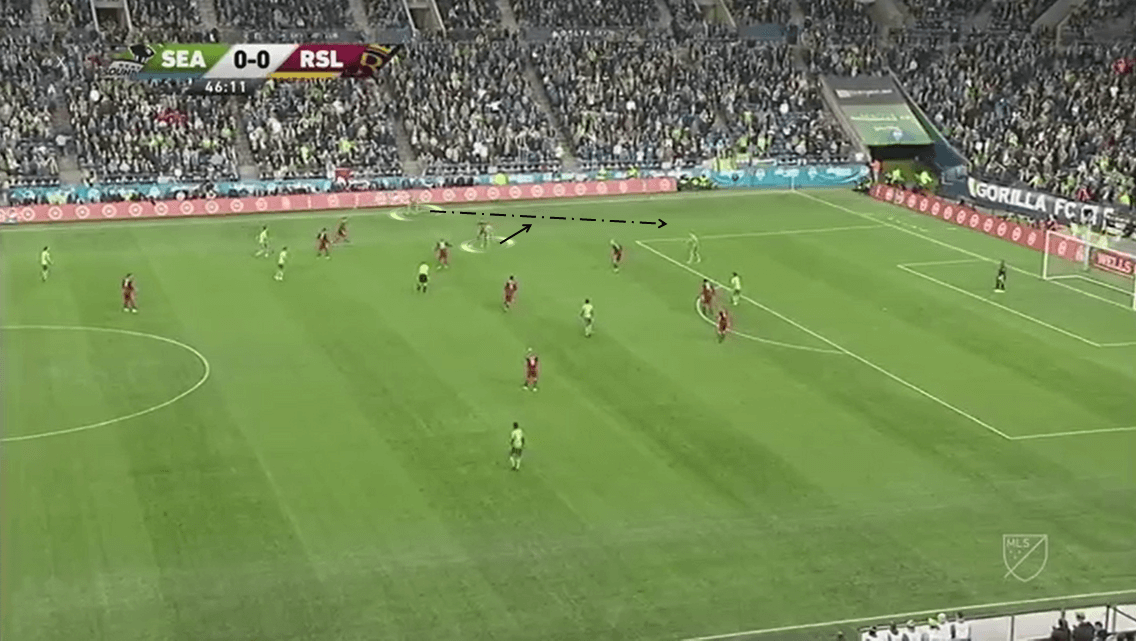
Smith has been particularly impressive this season in the role of an attacking full-back. His ability to make runs up and down that left flank plays a very important part in Schmetzer’s tactics as he is a competent crosser and a decent stopper for the team. Averaging 0.9 dribbles and 0.8 crosses per match, those numbers still don’t highlight his full ability. But with 1.1 long balls, 1.1 key passes and five assists to his name, it is enough to prove that the Bournemouth loanee is a threat that needs to be acknowledged in the final.
In the role of an inside forward, Morris has defined all expectations since his return from an ACL injury last year. From being a striker who is expected to lead the line and pops up at the end of passes, the 25-year-old forward is now thriving in the role of a winger that involves in situations that take place inside the left half-space. Ten matches playing in the role of a left-winger, he had five goals and four assists to his name.
But his versatility doesn’t stop there as he can also play on the right-hand side. With his pace, he can receive the ball and burst into the edge of the 16-yard box and drag along several defenders to create space for his teammates. Being able to link up with both full-backs is what helps Morris feels comfortable to play on both wings as it allows him to receive support more often and create combinations to progress the ball up the pitch.
Smith and Morris will certainly set up a very interesting clash with Toronto’s full-backs Auro Jr. and Justin Morrow. If the visitors want to limit Seattle’s attacking threat, closing down the left-hand side is the most viable option. But even when that flank is overloaded, the home side will remain consistent in breaking down that area by delaying the ball progression process and attempt to find gaps in between the defenders.
Overloading the central area is also important to prevent Seattle from distributing the ball in between the lines. Usually, central midfielder Cristian Roldan will move slightly higher to provide support for Lodeiro and become a possible passing option if his teammates opt to circulate the ball out of overloaded areas. This will allow their wingers to move even wider and offer to push the ball to the edge of the 16-yard box.
Which is why the chemistry between Toronto’s central midfielders will be one of the decisive factors in their defence. If one misunderstands the others, they will create gaps in between them for Lodeiro and Rudíaz to move in and attack their defensive line. When lining up in a 4-3-3, Toronto aim to stretch their defensive shape wide to cover up the central area and the half-spaces. At the same time, it makes the option of shifting the shape to either flank becomes viable.
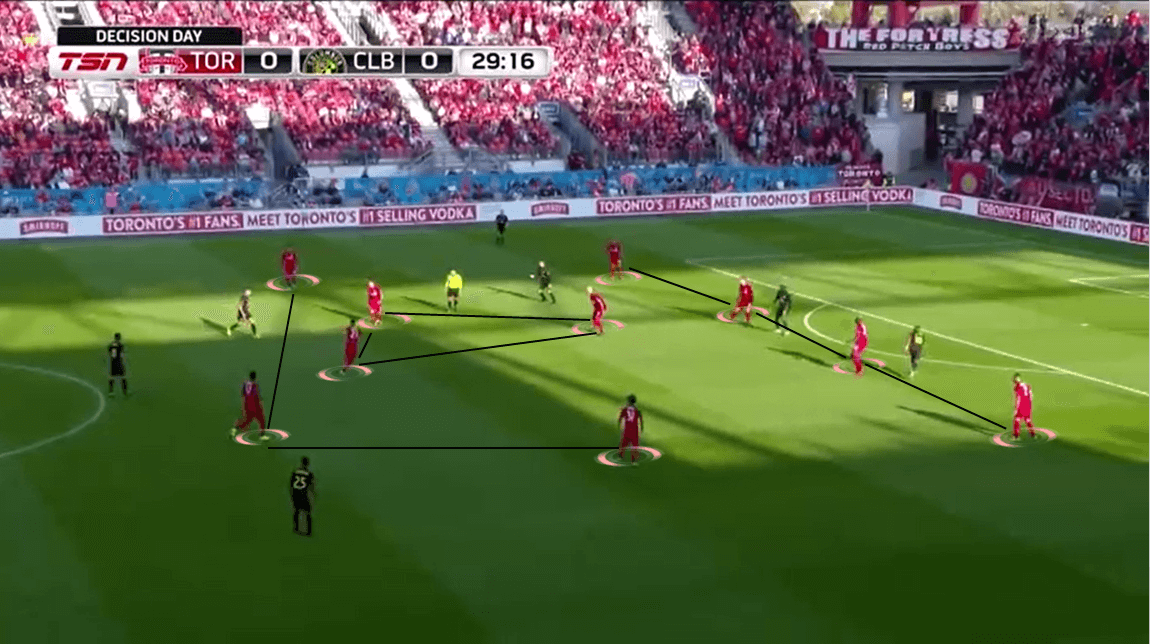
When the opposition progress the ball into their half, the attackers will be the first line to react as they attempt to close the ball carrier and his possible passing options down. In the meantime, Marco “Marky” Delgado and Jonathan Osorio will push up to provide support by intercepting through balls and passes coming towards them.
A player who plays an important role among Toronto’s defensive shape is Michael Bradley. The American veteran takes on the responsibilities of screening the space in front of the defensive line and drops deep whenever a centre-back decides to step out of his position. Still, the pace seems to be a major setback for the team’s captain as he sometimes finds himself struggling to catch up with the opposition’s attackers.
This can become a weakness that Seattle will look to exploit more in the match. From his position, Rudíaz can move close to the ball carrier and offer to pick the ball up. At the same time, he will also drag along one of Toronto’s defenders, leaving the space behind his back unoccupied. With both full-backs being pinned down by Seattle’s full-backs, Morris and Joevin Jones can move into that area to pick up the lofted pass. At times, the full-backs can also do a similar thing by cutting inside and attack the 16-yard box, similar to an inverted-wing-back.
This is when playing with a back-five becomes useful for Toronto. When one centre-back steps out of his position and one is pinned down by Lodeiro, they will have a spare man to fill in that space. Also, it doesn’t require Bradley to drop very deep into the team’s defensive third, which allows him to track the run of Roldan and prevents him from approaching the 16-yard box.
One of the problems that the visitors also need to take on the account is their high defensive line. Against Atlanta, this strategy was countered on many occasions and one of those occasions led to Julian Gressel’s opening goal. With Toronto committed players high up the pitch to involve in the press, they left the space in front of the defensive line unoccupied. This allowed Ezequiel Barco to receive the ball in a free state and even scanned for Gonzalo Martínez’s run. When the visitors attempted to retreat to stop the attack, no players were able to catch up with the former River Plate’s winger and Gressel’s pace, allowing the German player to have a free tap-in.
Having two pacey players in Rudíaz and Lodeiro, Seattle can adapt a similar strategy to Atlanta’s Josef Martínez and Pity Martínez. The former will drop off his position to pin one of Toronto’s defender down, while the latter moves into the blindside of the other centre-back to receive the through ball. Whether Toronto will remain pressing high up the pitch or not will determine if the home side can employ this plan to approach Westberg’s goal. But if they do, Toronto’s centre-backs will have an exhausting day dealing with the pace of Seattle’s attackers.
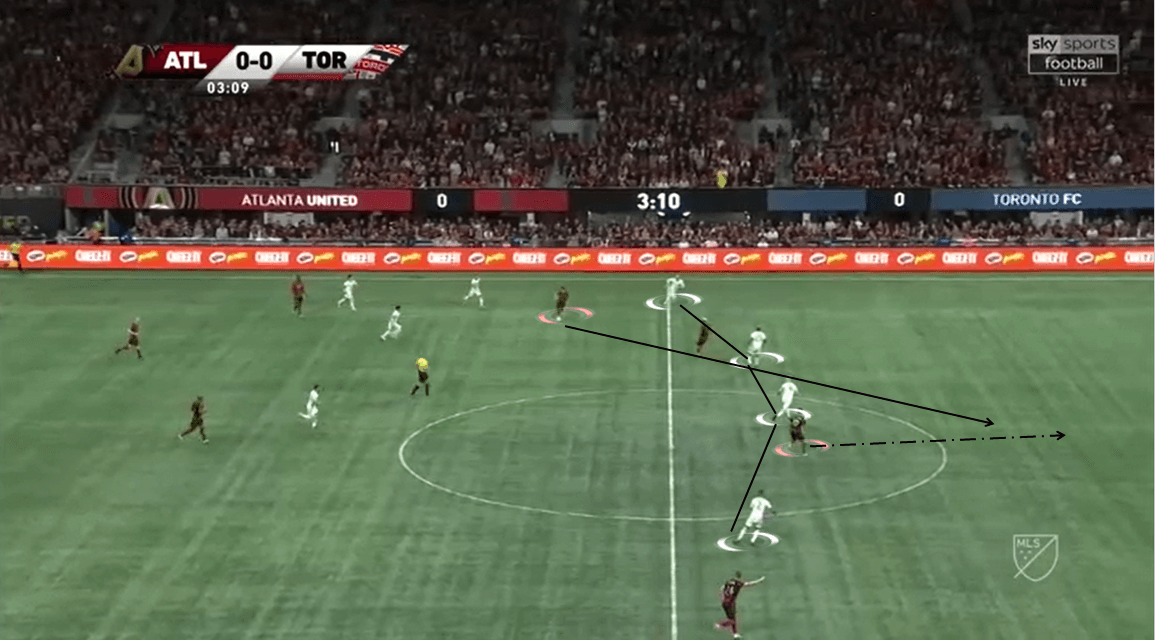
Seattle’s defence against Toronto’s attack
In contrast to Seattle, Toronto usually focus on playing out from the back. With two centre-backs position themselves near each other and both full-backs also stay deep on several occasions, they are able to keep the riskiness of their passes as low as possible. Furthermore, we have analysed about Bradley’s role in the team’s defence with him staying close to the defenders to screen the space in front of them. During the build-up, he also acts similarly by creating passing triangles with the players surround him.
Statistically speaking, the team’s captain is registering the highest number of passes (for players who have played more than ten matches) with an overwhelming 75.1 passes per game and completed 88.8% of them. Meanwhile, Gonzalez, Ciman and Mavinga’s records currently stand at 55.9 (82.6%), 45.4 (87.4%) and 43.4 (89%) respectively. These numbers are at a very respectable level and demonstrate how important they are to the build-up process.
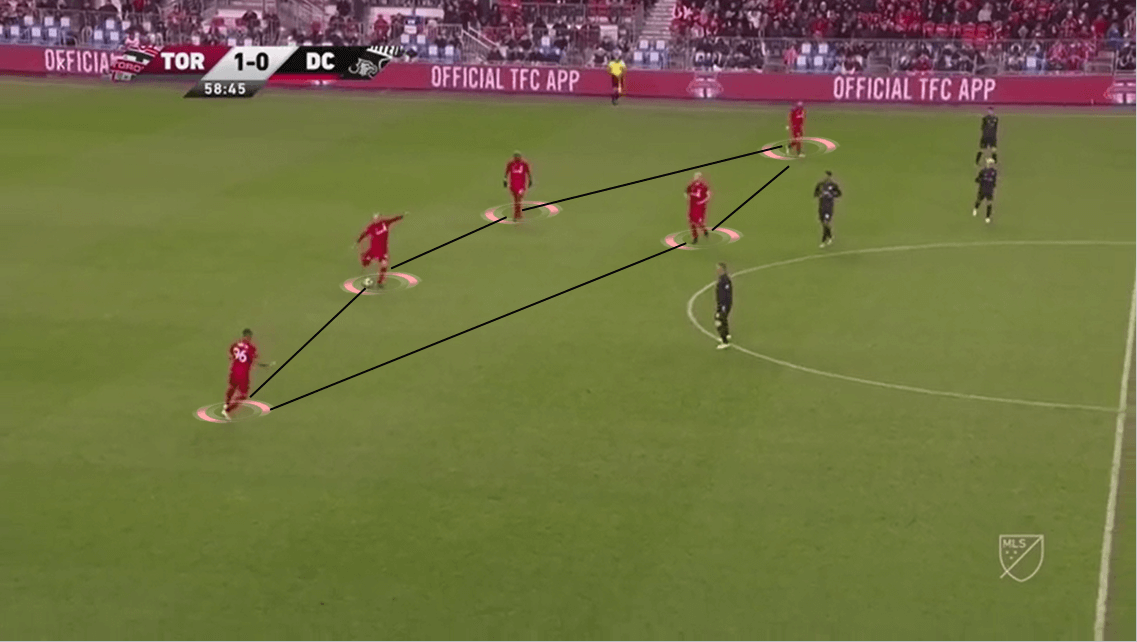
Still, playing against a side who press high like Seattle, the cautiousness in every passes is required if the away side aim to bypass the pressure to progress the ball up the field. The home side are expected to create a man-oriented press in which each attacker is responsible for one of the opposition’s defenders.
The aim is to disrupt the opposition’s build-up by eliminating potential receivers around the ball carrier and recover possession inside the opposition’s half. It is worth noting that Seattle are dangerous in counter-attacks with the pace of their attackers. Whenever a player controls the ball, his teammates will burst up the field while looking for a pocket of space to move in and become a viable passing option.
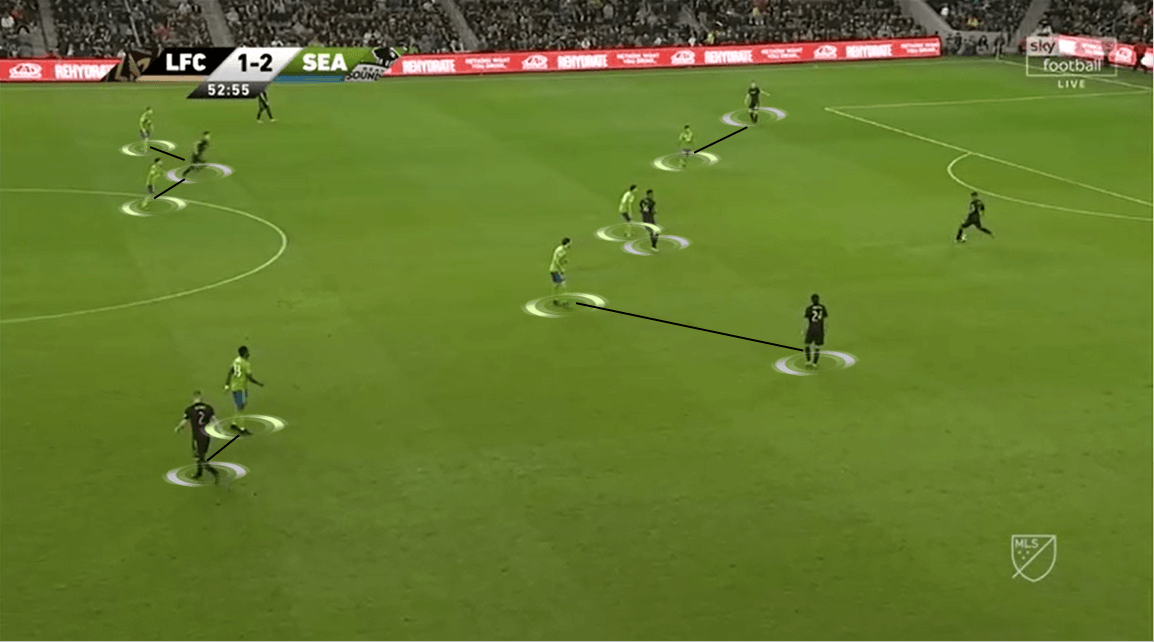
One option that Toronto defenders can make the most out of when they play out from the back is to use long balls towards the attackers. Pozuelo obviously isn’t a good option to direct their passes towards but either Mullins or Altidore is. They have the physicality to receive the ball with their back heading to the opposite goal and then lay it off to a teammate who is making a progressive run.
But when they opt to play with two wingers, distribute the ball to either wing seems like a more viable option. With Smith and Leerdam position themselves quite high, they could open space for Benezet and Endoh to receive the ball wide and feed it to the central midfielders. This can be a strategy which Toronto could choose if they are a goal down and want to push the players forward for that equaliser.
Seattle can be vulnerable during scenarios where they attempt to recover possession out wide. As their shape shifts to one side of the pitch, they will leave the other side unoccupied and create an opportunity for both the wing-back and the winger to enter, similar to the shot below. From the overloaded side, the ball carrier can send the ball to the opposite flank and invite both mentioned players to join the attack.
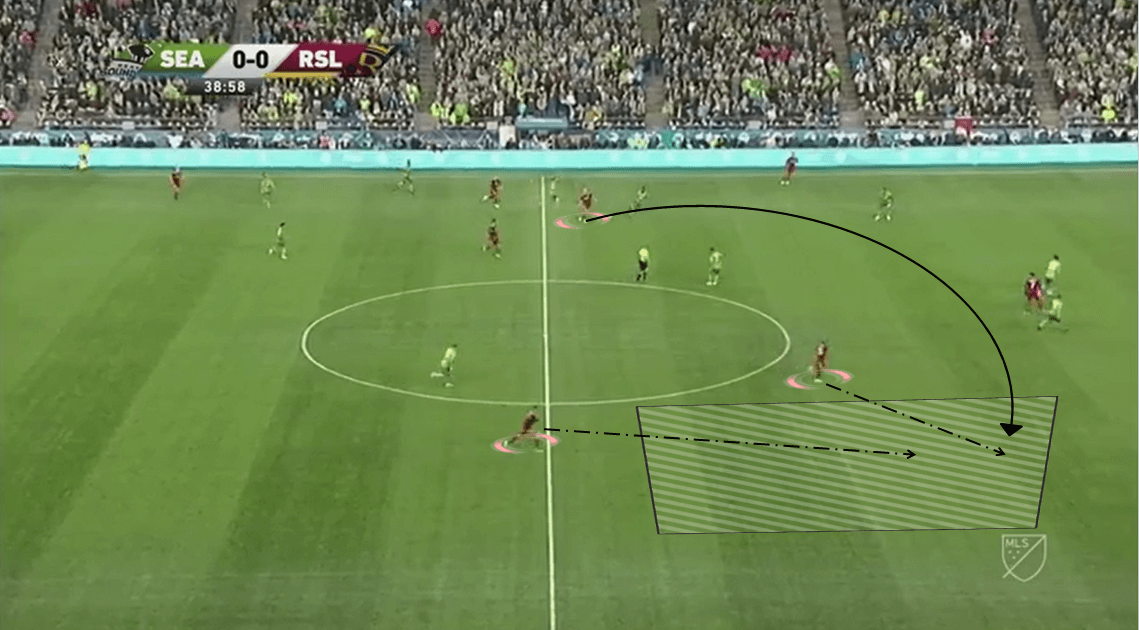
But if they line up in a 5-3-1-1 formation, being wing-oriented throughout the final will require Osorio and Delgado to shift wide more often. Similar to two mezzalas, they work more inside the half-spaces and provide support for the wing-backs. Having two more players moving out wide, it allows Toronto to stretch the opposition’s 4-2-3-1 defensive shape.
After bypassing the first two pressing lanes, the width will be the key for the Canadian side to progress the ball into the final third. The two strikers will pin down Seattle’s centre-backs while the central midfielders will be kept in sight by their full-backs. Therefore, Morrow and Auro will have the chance to overlap, receive the ball out wide and send crosses into the box for Mullins.

Along with that, Seattle also showed two major errors which Toronto can catch them asleep. Firstly, their defensive transitioning process can leave gaps between the lines for the attackers to exploit, similar to the shot below. With Pozuelo usually drops deep in his role of a false nine, the Spaniard can make the most out of this space to receive passes from the wing-backs and creates chances for the teammates who are arriving in the box.
Delgado can also take on this responsibility as he enters the box from his position. This will allow Pozuelo to focus on roaming across the edge of the 16-yard box to lure the defenders away and creates chances for his teammates. Flexibility is the factor that will play a huge part to help Toronto break the opposition’s defensive shape down.
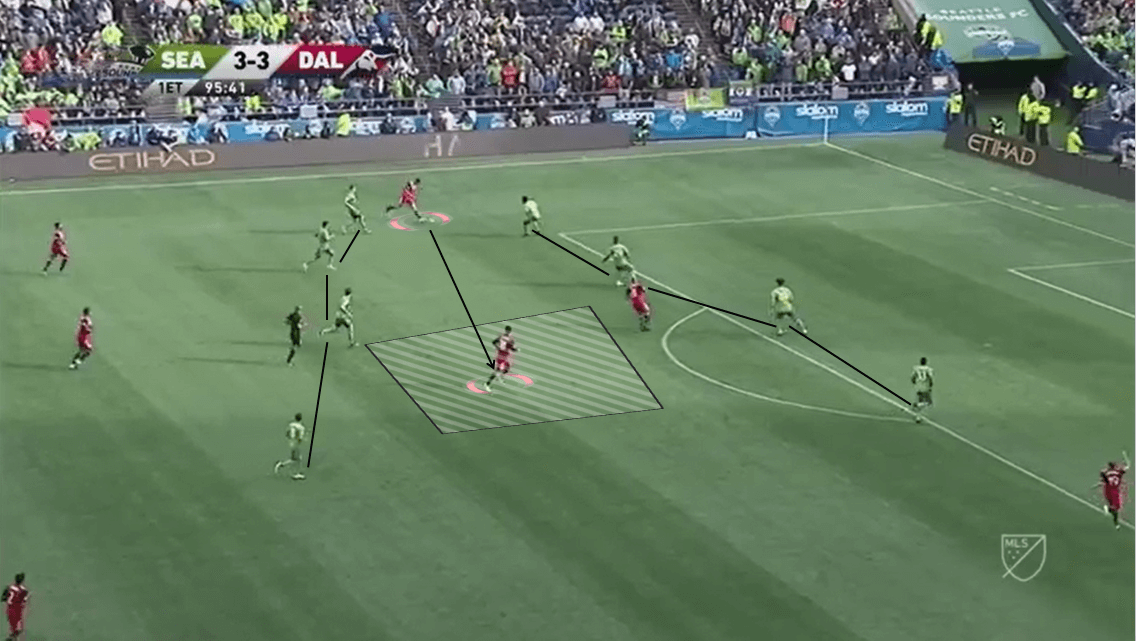
Secondly, Seattle usually struggles in terms of marking the opposition in both open play crosses and set-pieces. In the shot below, notice how Seattle committed players to the near post, leaving just two players aware of the far post. This allowed Bryan Acosta to enter the 6-yard box and had a free header towards the goal. Combined with the fact that Frei had an awful decision to come out, it even made Acosta’s goal came more easily.
This isn’t the only situation where Seattle defenders made a mistake in marking the opposition’s players as there were a few which occurred when crosses being sent into the box. Players who enter the blindside of defenders usually end up having such a great chance to score, which puts their goal in a vulnerable state on many occasions.
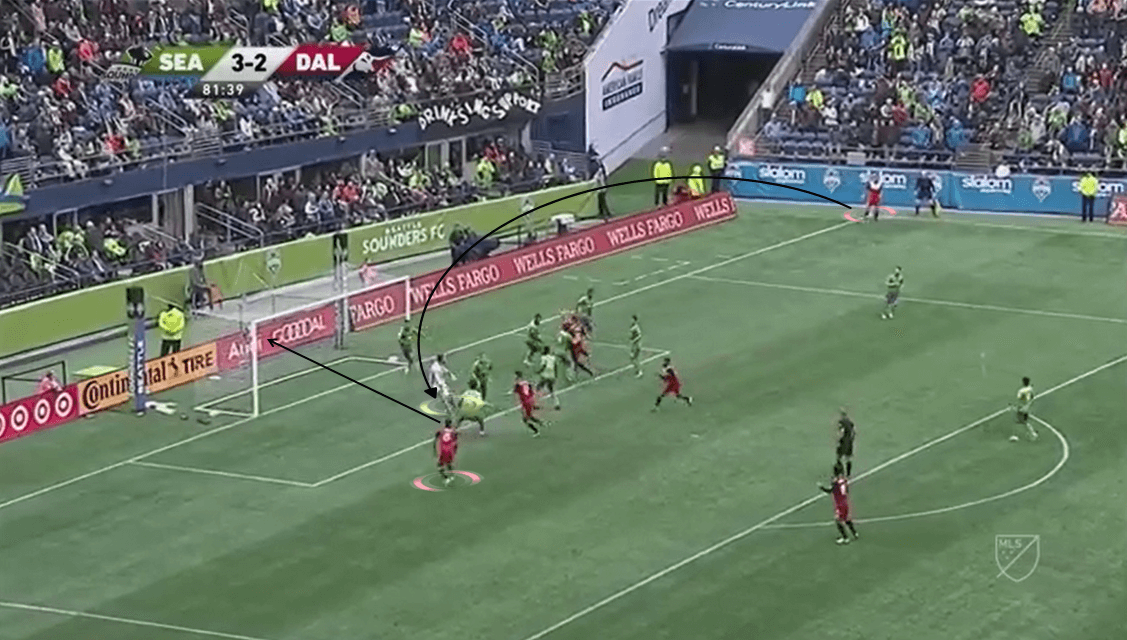
The key battle: Nicolas Lodeiro vs Alejandro Pozuelo
Whether if it is a 4-2-3-1 or a 4-3-3/3-5-1-1, the role of a playmaker plays a crucial role in both Seattle and Toronto’s tactics. In Lodeiro, Seattle have a player who has played in a higher level of football in Europe and has been a part of the Uruguayan national team. Playing just behind striker Rudíaz, Lodeiro tends to find pockets of space where he can position himself in and offer to receive the ball.
There, he has both time and space to do whatever he wants. From diminutive movements that lure the opposition’s defenders out of their positions and creates spaces for his teammates to move in, to aiming his passes towards Rudíaz’s run to allow the Peruvian striker to enter the box, it is all viable for Lodeiro. He is the main creative source in Seattle’s tactics, holding up the ball to bring his teammates into play and makes intelligent passes that set them in a state where they can continue the attack or converting the chance into a goal.
With 64.2 passes, 3.1 key passes, 3.1 long balls per game and five assists to his name, the numbers indicate how important he is to the team’s play. Furthermore, he only makes 0.8 dribbles per game, which shows his unselfish style of play and putting his teammates in front of him.
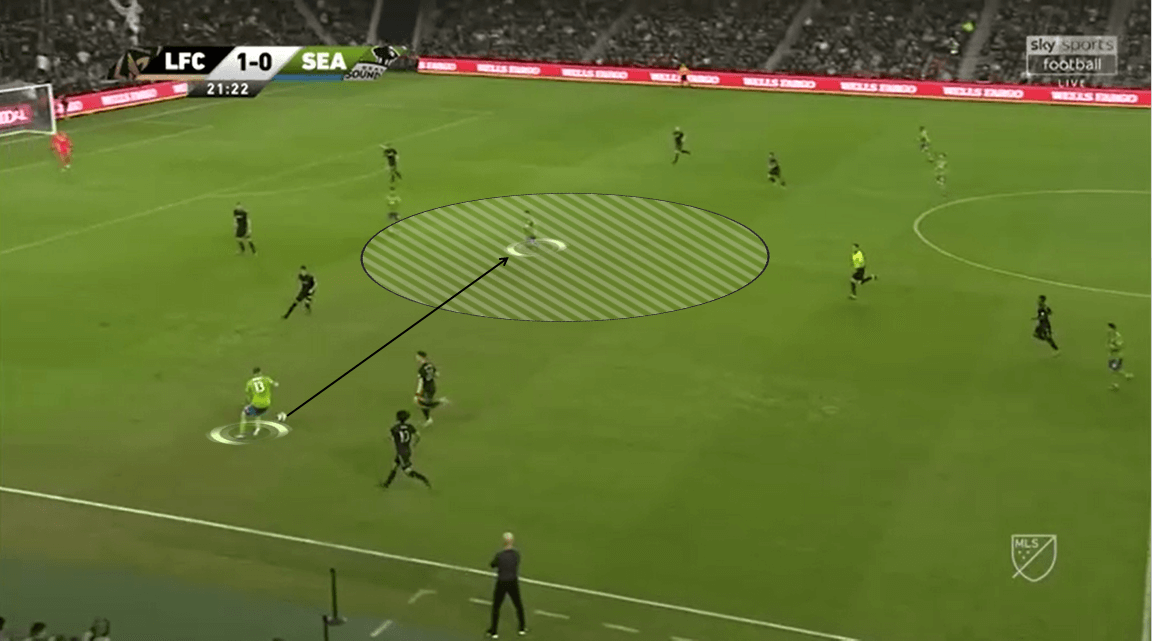
One of his strongest attributes is spatial awareness, where he continuously scanning for space to enter. Combined with the composure and concentration to execute his move, they usually end up in a positive outcome. In the shot below, notice how he identified the space in between Eduard Atuesta and Lee Nguyen.
But rather than immediately approached the gap and being into a more negative state, he patiently witnessed the central midfielders to enter the box and then executed his move. After receiving the ball from Leerdam, he had both space and time to aim his shot into the bottom right corner.
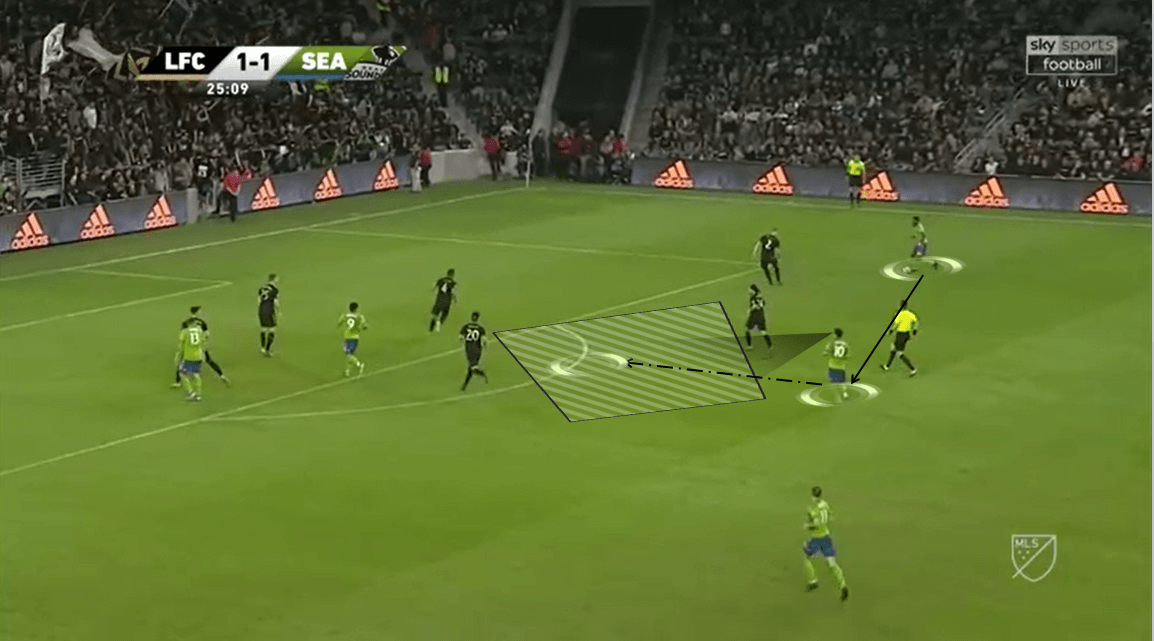
Defensively, Lodeiro involves heavily in the team’s pressing by positioning himself near the deepest central midfielder. In the match against LAFC, the Uruguayan international was usually seen marking Atuesta and intercepting passes that headed towards him. This helped Seattle to cut a possible passing lane while winning the ball high up the pitch to create a counter-attack towards the 16-yard box.
In the final with Toronto, he is expected to follow Bradley out of possession. This will disrupt the opposition’s build-up by eliminating a possible passing lane among the mentioned passing block. With the efficiency that he brought when employing the strategy against LAFC, it is expected to see more of the same from him in and out of possession.
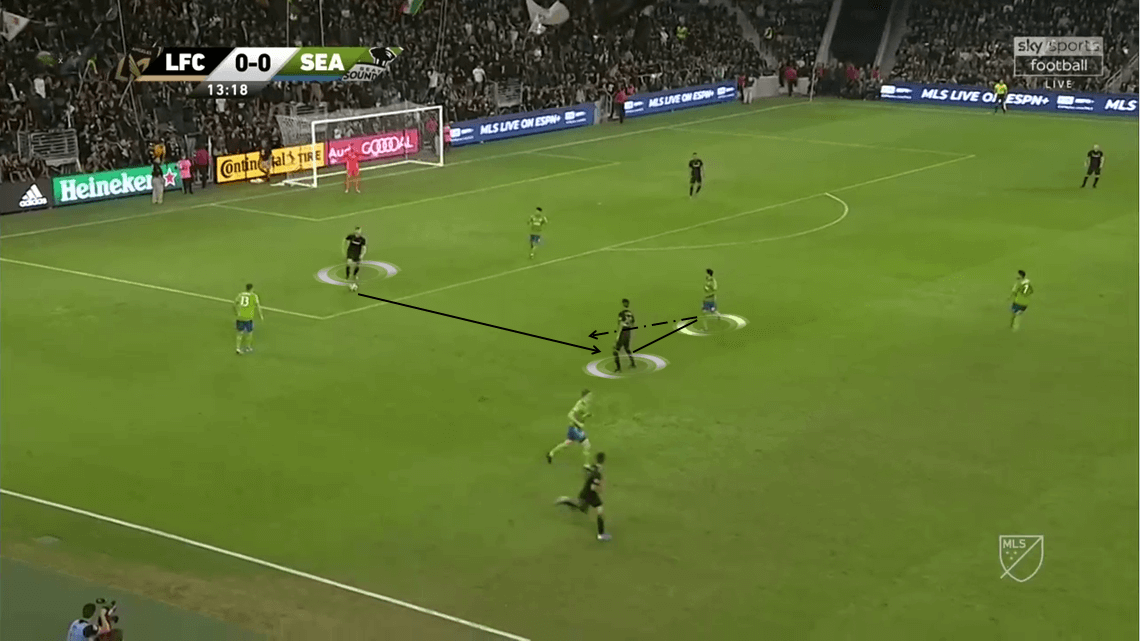
His opponent on the opposite side, though, is also another playmaker who is thriving since his arrival to the MLS. In the role of a false nine, Pozuelo has been the inspiration to lead Toronto into the play-off stage. He has contributed into the team’s play heavily by marking his mark in 23 goals, scoring fourteen of them and assisted nine. Replacing Altidore as the leading striker, the Spaniard midfielder also takes on a new role which fits his style of play.
From his position, he has the tendency of dropping into the midfield to link up with his teammates and pick up the ball. His movement usually drags along one of the opposition’s defender to create space for his teammates to move in, similar to Lodeiro. But in his case, two wingers will cut inside to capitalise the space, which reminds us about how Liverpool’s attacking trio is playing.
Not just Benezet and Endoh benefit from his style of play, but Mullins also makes the most out of the gaps that Pozuelo created, as shown in the shot below. This will be the type of combination which is expected in case Toronto line up in a 3-5-1-1. The former Genk midfielder will roam from his position more often, specifically come close to the central midfielders to bring them into play. Meanwhile, the Irish striker takes on the role of an advanced forward who sits on the shoulder of defenders and turns up at the end of through balls for a sprint towards the 16-yard box.
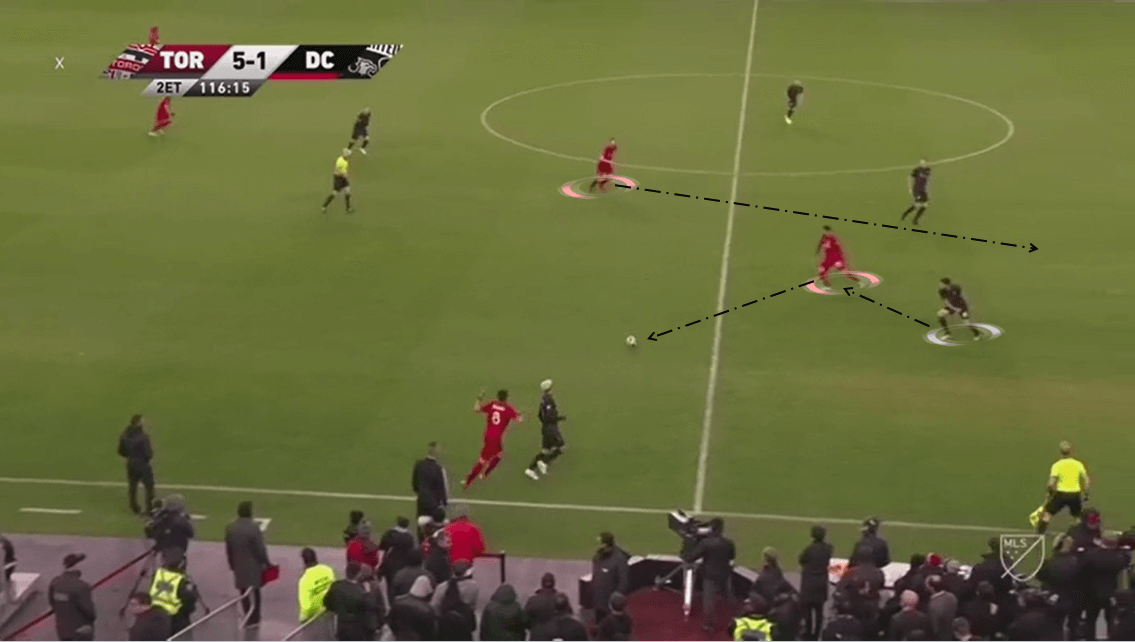
His spatial awareness is also one of his strongest attributes as he constantly roaming across the pitch looking for available pockets of space. This allows him to connect with more teammates and have a variety of option to distribute the ball towards. With 2.2 dribbles per game, it is quite clear to see how much he usually roams from his position just to put himself in a positive state to receive the ball.
Furthermore, it is also possible for him to create passing triangles wherever he travels to. Especially when the ball is trapped inside the overloaded area, his flexible movement can be used to transfer the ball outside of that area and maintain the team’s attack. Against a team who tend to overload one side of the pitch to win the ball back like Seattle, Pozuelo can make the most out of his runs to help the team progress the ball up the pitch while preventing the opposition from recovering possession.
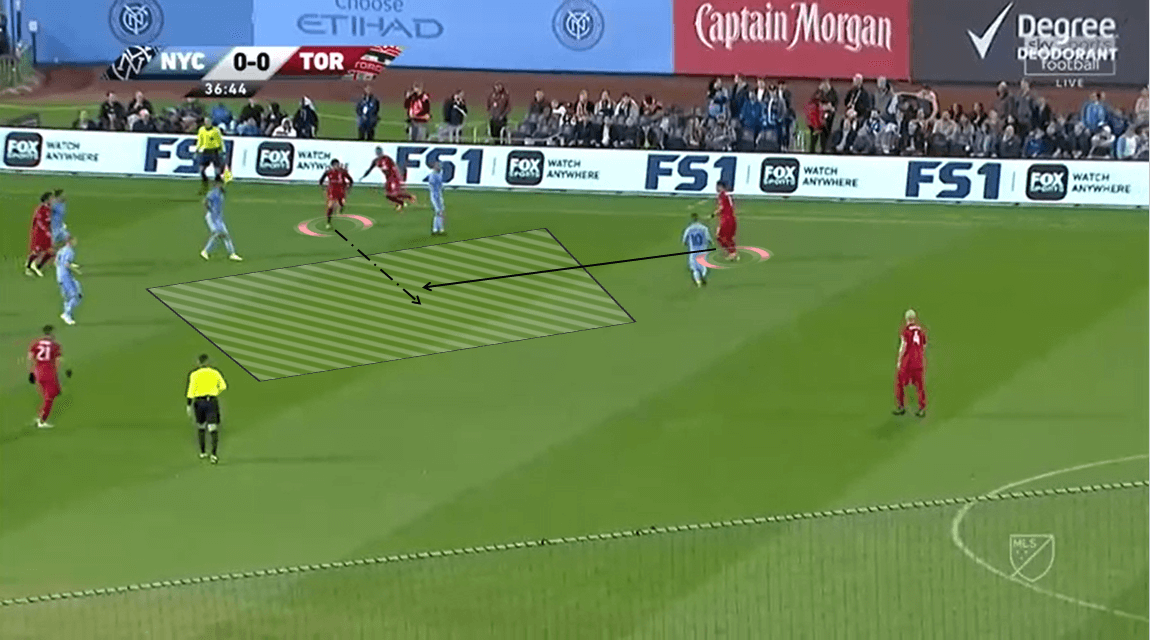
Conclusion
Having beaten several of the top-seeded teams, now Seattle and Toronto will face off each other in the final match of the season. There were moments that they found themselves struggled under pressure and had to count on luck to advance further. But there were times they proved their ability to overcome a hard challenge to eventually end up on the winning side in a convincing way.
Nonetheless, it all comes down to this one final moment at the CenturyLink Field. Both teams don’t want to be on the losing side and witness their opponent lifting up the trophy, especially Seattle. Playing in front of their own fans, they are expected to send them home in joy after this match where they will be crowned as champion. Meanwhile, Toronto want to create another sleepless night for their fans in Canada after they saw Toronto Raptors lifting up the NBA trophy earlier this year. Both all have their own expectation and momentum to fight for, and there is no doubt that the players are eager to walk out onto the field and show everything that they have to bring home the trophy.

If you love tactical analysis, then you’ll love the digital magazines from totalfootballanalysis.com – a guaranteed 100+ pages of pure tactical analysis covering topics from the Premier League, Serie A, La Liga, Bundesliga and many, many more. Buy your copy of the November issue for just ₤4.99 here




Comments